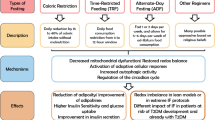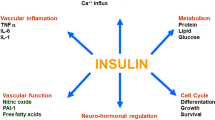Abstract
Insulin resistance and hyperinsulinemia have recently been identified as independent determinants of several risk factors for cardiovascular disease. The generation of reactive oxygen species (ROS) may play an important role as a final common mediator by which glucose and insulin resistance might contribute to development of cardiovascular disease and hypertension. The aim of the present study was to evaluate changes on mRNA expression of antioxidant enzymes [catalase, Cu-Zn superoxide dismutase (Cu-ZnSOD), MnSOD], blood pressure and metabolic parameters in insulin resistance that follow feeding normotensive Wistar rats a high-fructose-enriched diet. In our investigation 26 normal male Wistar rats were fed a highfructose diet for 2 weeks (no.=14) or normal chow to serve as a control group (no.=12). In vivo insulin resistance was verified in a subgroup of control and fructose-fed rats by the euglycemic hyperinsulinemic clamp technique at 2 different insulin infusion rates, 29 (submaximal stimulation) and 290 (maximal stimulation) pmol/kg/min respectively. The glucose infusion rate (GIR) was not significantly different in the two groups during the submaximal infusion of insulin (1.4±0.8 mmol/kg/min in fructosefed rats vs 1.6±0.7 mmol/kg/min in control rats, NS) while in fructose-fed rats it was significantly lower (-29.8%) than in control rats during maximal infusion of insulin (2.6±0.3 mmol/kg/min vs 3.7±0.3 mmol/kg/min, p<0.05). Fructose feeding markedly reduced the expression of catalase mRNA and Cu-ZnSOD mRNA in the liver, catalase mRNA in the heart (p<0.05). A tendency of fructose feeding to reduce the expression of antioxidant enzymes in skeletal muscle and adipose tissue was also observed (NS). Fructose feeding also increased plasma uric acid (119.9±30.4 vs 42.1±10 μmol/l, p<0.05) and systemic blood pressure (128±4 vs 109±5 mmHg, p<0.05) respect to control animals. No significant changes were observed in plasma levels of glycemia and tryglycerides. Our study suggests that in non-hyperglycemic, fructose-fed insulin-resistant rats the expression of catalase is inhibited in liver and heart. This condition might lead to higher susceptibility to oxidative stress in insulin resistance. However, an adaptive cellular response to maintain the effectiveness of intracellular signaling pathways mediated by insulinactivated hydrogen peroxide generating systems may also be hypothesized.
Similar content being viewed by others
References
Janssen Y.M., Van Houten B., Borm P.J., Mossman B.T. Cell and tissue responses to oxidative damage. Lab. Invest. 1993, 69: 261–274.
Mates J.M., Perez-Gomez C., Nunez de Castro I. Antioxidant enzymes and human diseases. Clin. Biochem. 1999, 32: 595–603.
Harris E.D. Regulation of antioxidant enzymes. FASEB J. 1992, 6: 2675–2683.
Darley-Usmar V., Halliwell B. Blood radicals: reactive nitrogen species, reactive oxygen species, transition metal ions, and the vascular system. Pharm. Res. 1996, 13: 649–662.
Giugliano D., Ceriello A., Paolisso G. Oxidative stress and diabetic vascular complications. Diabetes Care 1996, 19: 257–267.
Ceriello A. Oxidative stress and glycemic regulation. Metabolism 2000, 49(Suppl. 1): 27–29.
Paolisso G., Giugliano D. Oxidative stress and insulin action: is there a relationship? Diabetologia 1995, 39: 357–363.
Hamaty M., Lamberti M., Sowers J.M. Diabetic vascular disease and hypertension. Curr. Opin. Cardiol. 1998, 13: 298–303.
Ceriello A., Pirisi M. Is oxidative stress the missing link between insulin resistance and atherosclerosis? Diabetologia 1995, 38: 1484–1485.
Hwang I.S., Ho H., Hoffman B.B., Reaven G.M. Fructose-induced insulin resistance and hypertension in rats. Hypertension 1987, 10: 512–516.
Reaven G.M. Insulin resistance, hyperinsulinemia, hypertriglyceridemia and hypertension: parallels between human disease and rodent models. Diabetes Care 1991, 14: 195–202.
Lee M.K., Miles P.D., Khoursheed M., Gao K.M., Moossa A.R., Olefsky J.M. Metabolic effects of Troglitazone on fructose-induced insulin resistance in the rat. Diabetes 1994, 43: 1435–1439.
Chomezinsky P., Sacchi N. A single step method of RNA isolation by acid guanidinium thiocyanate -phenol chloroform extraction. Annal. Biochem. 1987, 162: 157–159.
Amstad P., Peskin A., Shah G., Mirault M.E., Moret R., Zbinden I., Cerutti P. The balance between Cu, Zn-superoxide dismutase and catalase affects the sensitivity of mouse epidermal cells to oxidative stress. Biochemistry 1991, 30: 9305–9313.
Faure P., Rossini E., Lafond J.L., Richard M.J., Favier A., Halimi S. Vitamin E improves the free radical defense system potential and insulin-sensitivity of rats fed with high fructose diets. J. Nutr. 1997, 123: 103–107.
Habib M.P., Dickerson F.D., Mooradian A.D. Effect of diabetes, insulin and glucose load on lipid peroxidation in the rat. Metabolism 1994, 43: 1442–1445.
Paolisso G., D’Amore A., Balbi V., Volpe C., Galzerano C., Giugliano D., Sgambato S., Varricchio M., D’Onofrio F. Plasma vitamin C affects glucose homeostasis in healthy subjects and non-insulin dependent diabetics. Am. J. Physiol. Endocrinol. Metab. 1994, 266: E261–E268.
Nolan J.J., Ludvik B., Beerdsen P., Joyce M., Olefski J. Improvement in glucose tolerance and insulin resistance in obese subjects treated with troglitazone. N. Engl. J. Med. 1994, 331: 1188–1193.
Halliwell B., Gutteridge J.M.C. Free radicals in biology and medicine, ed. 2. Clarendon Press, Oxford, 1995.
Suzuki Y.J., Forman H.J., Sevanian A. Oxidants as stimulators of signal transduction. Free Radic. Biol. Med. 1997, 22: 269–285.
Eizirik D.L., Flodstrom M., Karlsen A.E., Welsh N. The harmony of the spheres: inducible nitric oxide synthase and related genes in pancreatic beta cells. Diabetologia 1996, 39: 875–890.
Ramasarma T. Generation of H2O2 in biomembranes. Biochim. Biophys. Acta 1982, 694: 69–93.
Storz G.A., Tartaglia L.A., Ames B.N. Transcriptional regulator of oxidative stress-inducible genes: direct activation by oxidation. Science 1990, 248: 189–194.
Malter J.S., Hong Y. A redox switch and phosphorylation are involved in the post-translational up-regulation of the adenosine- uridine binding factor by phorbol ester and ionophore. J. Biol. Chem. 1991, 266: 3167–3171.
Krieger-Bauer H.I., Kather H. Human fat cells possess a plasma membrane-bound H2O2-generating system that is activated by insulin via a mechanism bypassing the receptor kinase. J. Clin. Invest. 1992, 89: 1006–1013.
Housley M.D. Crosstalks: a pivotal role for protein kinase C in modulating relationships between signal transduction pathways. Eur. J. Biochem. 1991, 195: 9–27.
Tiedge M., Lortz S., Drinkgern J., Lenzen S. Relation between antioxidant gene expression and antioxidative defense status of insulin-producing cells. Diabetes 1997, 46: 1733–1742.
Michiels C., Raes M., Touissaint O., Remacle J. Importance of Se-glutathione peroxidase, catalase and Cu/Zn SOD for cell survival against oxidative stress. Free Radic. Biol. Med. 1994, 17: 235–248.
Faure P., Rossini E., Wiernsperger N., Richard M.J., Favier A., Halimi S. An insulin sensitizer improves the free radical defense system potential and insulin sensitivity in high fructose-fed rats. Diabetes 1999, 48: 353–357.
Fields M., Ferretti R.J., Reiser S., Smith J.C. The severity of copper deficiency in rats is determined by the type of diet carbohydrate. Proc. Soc. Exp. Biol. Med. 1984, 175: 530–537.
Bray T.M., Bettger W.J. The physiological role of zinc as antioxidant. Free Radic. Res. Med. 1990, 8: 281–291.
Faure P., Roussel A.M., Martini M., Favier A., Halimi S. Insulin-sensitivity in zinc-depleted rats: assessment with the euglycemic hyperinsulinemic clamp technique. Diabetes Metab. 1991, 17: 325–331.
Fujii Y., Taniguchi N. Down regulation of superoxide dismutases and glutathione peroxidase by reactive oxygen and nitrogen species. Free Rad. Res. 1999, 31: 301–308
Yamamoto T., Moriwaki Y., Takahashi S., Yamakita J., Tsutsumi Z., Ohata H., Hirohishi K., Nakano T., Higashino K. Effect of ethanol and fructose on plasma uridine and purine bases. Metabolism 1997, 46: 544–547.
Buemann B., Toubro S., Holst J.J., Rehfeld J.F., Bibby B.M., Astrup A. D-Tagatose, a stereoisomer of D-fructose, increased blood uric acid concentration. Metabolism 2000, 49: 969–976.
De Fronzo R.A., Ferranini E. Insulin resistance: a multi-faceted syndrome responsible for NIDDM, obesity, hypertension, dyslipidemia, and atherosclerotic cardiovascular disease. Diabetes Care 1991, 14: 173–194.
Wiedmann P., Ferrari P. Central role of sodium in hypertension in diabetic subjects. Diabetes Care 1991, 14: 220–232.
Anderson E.A., Mark A.L. The vasodilator action of insulin: implications for the insulin hypothesis of hypertension. Hypertension 1993, 21: 745–751.
Reaven G.M., Lithell H., Landsberg L. Hypertension and associated metabolic abnormalities. The role of insulin resistance and the sympathoadrenal system. N. Engl. J. Med. 1996, 334: 374–381.
Author information
Authors and Affiliations
Corresponding author
Rights and permissions
About this article
Cite this article
Cavarape, A., Feletto, F., Mercuri, F. et al. High-fructose diet decreases catalase mRNA levels in rat tissues. J Endocrinol Invest 24, 838–845 (2001). https://doi.org/10.1007/BF03343940
Accepted:
Published:
Issue Date:
DOI: https://doi.org/10.1007/BF03343940




